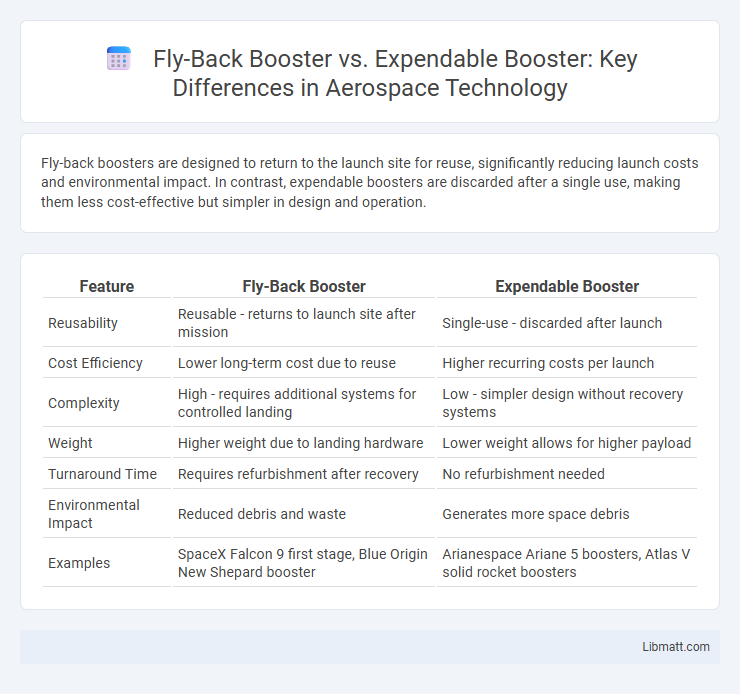Fly-back boosters are designed to return to the launch site for reuse, significantly reducing launch costs and environmental impact. In contrast, expendable boosters are discarded after a single use, making them less cost-effective but simpler in design and operation.
Table of Comparison
| Feature | Fly-Back Booster | Expendable Booster |
|---|---|---|
| Reusability | Reusable - returns to launch site after mission | Single-use - discarded after launch |
| Cost Efficiency | Lower long-term cost due to reuse | Higher recurring costs per launch |
| Complexity | High - requires additional systems for controlled landing | Low - simpler design without recovery systems |
| Weight | Higher weight due to landing hardware | Lower weight allows for higher payload |
| Turnaround Time | Requires refurbishment after recovery | No refurbishment needed |
| Environmental Impact | Reduced debris and waste | Generates more space debris |
| Examples | SpaceX Falcon 9 first stage, Blue Origin New Shepard booster | Arianespace Ariane 5 boosters, Atlas V solid rocket boosters |
Introduction to Booster Technologies
Fly-back boosters incorporate reusable technology allowing controlled return and landing, significantly reducing launch costs compared to traditional expendable boosters. Expendable boosters are designed for single-use missions, providing maximum thrust without recovery considerations but resulting in higher long-term expenses. Advances in materials and guidance systems have enabled fly-back boosters to achieve efficient reusability while maintaining performance metrics comparable to expendable counterparts.
What is a Fly-Back Booster?
A Fly-Back Booster is a reusable rocket booster designed to return to its launch site after separating from the main rocket, enabling multiple launches and reducing space mission costs. Unlike Expendable Boosters, which are discarded and lost after use, Fly-Back Boosters use aerodynamic surfaces and engines to fly back autonomously, improving sustainability in spaceflight. Your choice between these boosters impacts mission economics, environmental footprint, and launch vehicle design complexity.
What is an Expendable Booster?
An expendable booster is a rocket stage designed for single use, detaching from the main vehicle and falling back to Earth without recovery. These boosters provide the initial thrust needed to propel spacecraft into orbit but are discarded to reduce weight and improve efficiency for the remaining stages. Expendable boosters are commonly used in launch systems where reusability is not a priority, maximizing payload capacity while keeping costs associated with recovery and refurbishment minimal.
Key Differences: Fly-Back vs Expendable Boosters
Fly-back boosters are designed to return to the launch site for reuse, employing wings and engines for controlled descent, significantly reducing overall launch costs. Expendable boosters, in contrast, are single-use components that detach and fall into the ocean or remote areas, making them less cost-efficient but simpler in design. Your choice between these boosters impacts mission economics, sustainability, and turnaround time.
Cost Comparison and Economic Impact
Fly-back boosters significantly reduce launch costs by being reusable, allowing multiple flights per unit compared to single-use expendable boosters that require manufacturing a new booster for each launch. The economic impact of fly-back boosters includes lower operational expenses and increased launch cadence, fostering greater accessibility in satellite deployment and space exploration. Conversely, expendable boosters generate higher material and production costs, limiting frequency and scalability within the current space industry economics.
Environmental Impact and Sustainability
Fly-back boosters significantly reduce environmental impact by enabling reusability, which minimizes rocket debris and lowers the demand for resource-intensive manufacturing processes compared to expendable boosters that are discarded after a single launch. The reusable nature of fly-back boosters decreases carbon emissions associated with production and transportation of new boosters, contributing to more sustainable spaceflight operations. Conversely, expendable boosters generate more solid waste and require continual extraction of raw materials, increasing their ecological footprint and hindering long-term sustainability goals.
Performance and Payload Capabilities
Fly-back boosters are designed with integrated aerodynamic surfaces and jet engines, enabling controlled return and reuse, which reduces launch costs but slightly compromises maximum payload capacity due to additional weight and complexity. Expendable boosters prioritize thrust-to-weight ratio and structural simplicity, maximizing payload performance by dedicating all propellant and mass towards launch efficiency without recovery systems. Performance trade-offs favor expendable boosters for heavy payload launches, while fly-back boosters offer sustainable recovery benefits with moderate payload reductions.
Reusability: Advantages and Challenges
Fly-back boosters offer significant reusability advantages by returning to the launch site using onboard propulsive or aerodynamic systems, reducing refurbishment costs and turnaround time compared to expendable boosters that are discarded after a single flight. Challenges include the complexity of designing reliable controlled descent and landing mechanisms while managing additional weight and fuel requirements that can reduce payload capacity. Expendable boosters avoid these challenges but incur higher long-term costs due to manufacturing new boosters for each mission, limiting cost efficiency over multiple launches.
Market Adoption and Industry Trends
Fly-back boosters are gaining traction in the aerospace market due to their reusability, significantly reducing launch costs and increasing launch cadence compared to traditional expendable boosters, which are discarded after each mission. Industry trends show major players like SpaceX and Blue Origin driving adoption of reusable technology, prompting shifts in investment and development toward sustainable launch solutions. While expendable boosters still dominate certain sectors due to lower upfront costs and established supply chains, the rapid innovation and environmental benefits of fly-back boosters are accelerating their market share growth globally.
Future Prospects of Booster Technologies
Fly-back boosters, designed for vertical landing and reuse, promise significant cost reductions and sustainability in space launch operations compared to traditional expendable boosters, which are discarded after a single use. Future advancements in materials, propulsion efficiency, and autonomous landing technologies are expected to enhance the reliability and turnaround time of fly-back boosters, further accelerating commercial and governmental space missions. Innovations in expendable booster designs may continue but are unlikely to match the economic and environmental benefits of reusable fly-back systems, indicating a clear industry shift toward sustainable booster technologies.
Fly-Back Booster vs Expendable Booster Infographic

 libmatt.com
libmatt.com